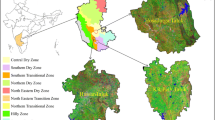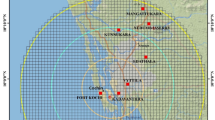Abstract
Land change science (LCS) strives to understand and model land-use change, which will further advance the understanding of multiple issues in the socio-ecological systems. Based on GIS/RS techniques, autologistic model, and household survey method, this study investigated major land use changes and their causes from 1978 to 2008 in Uxin Banner (county-level), Inner Mongolia in China and then developed an understanding of the relationships between household livelihood and land-use pattern. Results showed that cultivated land increased from 1988 to 2000, and leveled off after 2000. Built-up land increased stably for the period 1978–2008. The change of grassland and bare land differed among the three periods. From 1978 to 1988, grassland increased by 23.3%, and bare land decreased by 20.48%. From 1988 to 2000, bare land expanded by 1.7%, but grassland declined by 1.3%. From 2000 to 2008, an increase in grassland area by 1.8% was observed, but a decrease in bare land area by 9.0% was witnessed. The autologistic models performed better than logistic models as indicated by lower Akaike Information Criterion (AIC) values. Factors associated with human activities significantly correlated with the change of cultivated land, forest land, grassland, and built-up land. The produce prices and extensive cultivated land use are major issues in the farming area. This study suggests that completing land circulation systems and maintaining the stability of price are effective solutions. By contrast, reclamation and overgrazing are major concerns in the pastoral areas. Implementing environmental policies effectively, transferring population out of rural pastoral areas, and developing modern animal husbandry are effective ways to address these issues.
Similar content being viewed by others
References
Augustin N H, Mugglestone M A, Buckland S T, 1996. An autologistic model for the spatial distribution of wildlife. Journal of Applied Ecology, 33(2): 339–347. doi: 10.2307/2404755
Burnicki A, Brown D G, Goovaerts P, 2007. Simulation error propagation in land-cover change analysis: The implications of temporal dependence. Computers Environment and Urban System, 31(3): 282–302. doi: 10.1016/j.compenvurbsys.2006.07.005
Chambers R, 1994. The origins and practice of participatory and rural appraisal. World Development, 22(7): 953–969. doi: 10.1016/0305-750X(94)90141-4
Coppin P, Jonckheere I, Nackaerts K et al., 2004. Digital change detection methods in ecosystem monitoring: A review. International Journal of Remote Sensing, 25(9): 1565–1596. doi: 10.1080/0143116031000101675
Cramb R A, Purcell T, Ho T C S, 2004. Participatory assessment of rural livelihoods in the Central Highlands of Vietnam. Agricultural Systems, 81(3): 255–272. doi: 10.1016/j.agsy.2003.11.005
de Koning G H J, Veldkamp A, Fresco L O, 1998. Land use in Ecuador: A statistical analysis at different aggregation levels. Agriculture, Ecosystem and Environment, 70(2–3): 231–247. doi: 10.1016/S0167-8809(98)00151-0
de Nijs T, Pebesma E, 2010. Estimating the influence of the neighborhood in the development of residential areas in the Netherlands. Environmental Planning B, 37(1): 21–41. doi: 10.1068/b35021
Deng Xiangzheng, Liu Jiyuan, Zhan Jinyan et al., 2004. Dynamic simulation on the spatio-temporal patterns of land use change in Taibus County. Geographical Research, 23(2): 147–156. (in Chinese)
GLP (Global Land Project), 2005. Science Plan and Implementation Strategy. IGBP Report No. 53/IHDP Report No. 19. Stockholm: IGBP Secretariat.
Guo Jian, Wang Tao, Han Bangshuai et al., 2008. Dynamic process of Aeolian desertification land variation in Mu Us sandy land and its surrounding area in recent 30 years. Journal of Desert Research, 28(6): 1017–1021. (in Chinese)
Kok K, Veldcamp A, 2001. Evaluating impact of spatial scales on land use pattern analysis in Central America. Agriculture, Ecosystem and Environment, 85(1–3): 205–221. doi: 10.1016/S0167-8809(01)00185-2
Li Xiaojian, 2002. The role of rural household behavior in economic development of less developed rural area: A case study of western Henan Mountainous and hilly region, China. Acta Geographica Sinica, 57(4): 459–468. (in Chinese)
Liao Shunbao, Liu Rui, Yin Fang, 2011. Validation for accuracy of land cover remote sensing mapping of China at scale of 1: 250000 in East Inner Mongolia. Geographical Research, 30(3): 555–563. (in Chinese)
Liu Aimin, Ci Longjun, 1997. A systematic analysis of the manmade influence in modern desertification process. Journal of Natural Resources, 12(7): 211–218. (in Chinese)
Lu D, Mausel P, Brondizio E et al., 2004. Change detection techniques. International Journal of Remote Sensing, 25(12): 2365–2401. doi: 10.1080/0143116031000139863
Meng Jijun, Yan Fen, 2009. Temporal and spatial variation of LUCC driving forces on the edge of metropolis: A case study of Changping district. Acta Scientiarum Naturalium Universitatis Pekinensis, 45(2): 311–318. (in Chinese)
Ouyang Jinliang, Song Chunmei, Yu Zhenrong et al., 2004. The farming household’s choice of land use type and its effecttiveness on land quality and environment in Huang-Huai-Hai Plain. Journal of Natural Resources, 19(1): 1–11. (in Chinese)
Overmars K P, de Koning G H J, Veldcamp A, 2003. Spatial autocorrelation in multi-scale land use models. Ecological Modelling, 164(2–3): 257–270. doi: 10.1016/S0304-3800(03)00070-X
Pontius Jr R G, Li X X, 2010. Land transition estimates from erroneous maps. Journal of Land Use Science, 5(1): 31–44. doi: 10.1080/17474230903222473
Rindfuss R R, Walsh S J, Turner II B L et al., 2004. Developing a science of land change: Challenges and methodological issues. Proceedings of the National Academy of Science of the United States of America, 101(39): 13976–13981. doi: 10.1073/pnas.0401545101
Serneels S, Lambin E F, 2001. Proximate causes of land-use change in Narok District, Kenya: A spatial statistical model. Agricultural, Ecosystem and Environment, 85(1–3): 65–81. doi: 10.1016/S0167-8809(01)00188-8
Shao Jing’an, Wei Chaofu, Xie Deti, 2006. AAn insight on drivers of land use change at regional scale. Chinese Geographical Science, 16(2): 176–182. doi: 10.1007/s11769-006-0014-5
Song Naiping, Zhang Fengrong, 2007. The changing process and mechanism of the farming-grazing transitional land use pattern in Ordos. Acta Geographica Sinica, 62(12): 1299–1308. (in Chinese)
Tan Shuhao, Qu Futian, Huang Xianjin, 2001. Difference of farm households’ land use decision-making and land conservation policies under market economy. Journal of Nanjing Agricultural University, 24(2): 110–114. (in Chinese).
Turner II B L, Kapserson R E, Matson P A et al., 2003. A framework for vulnerability analysis in sustainability science. Proceedings of the National Academy of Science of the United States of America, 100(14): 8074–8079. doi: 10.1073/pnas.1231335100
Turner II B L, Lambin E F, Reenberg A, 2007. The emergence of land change science for global environmental change and sustainability. Proceedings of the National Academy of Science of the United States of America, 104(52): 20666–20671. doi: 10.1073/pnas.0704119104
Veldkamp A, Fresco L O, 1997. Reconstructing land use drivers and their spatial scale dependence for Costa Rica (1973 and 1984). Agricultural Systems, 55(1): 19–43. doi: 10.1016/S0308-521X(95)00080-0
Wang Jingai, Xu Xia, Liu Peifang, 1999. Land use and land carrying capacity in ecotone between agriculture and animal husbandry in Northern China. Resources Science, 21(5): 19–24. (in Chinese)
Wang X H, Lu C H, Fang J F et al., 2007. Implications for development of Grain-for-Green policy based on cropland suitability evaluation in desertification-affected north China. Land Use Policy, 24(2): 417–424. doi: 10.1016/j.landusepol.2006.05.005
Wang Xiulan, Bao Yuhai, 1999. Study on the methods of land use dynamic change research. Progress in Geography, 18(1): 81–87. (in Chinese)
Ward M D, Gleditsch K S, 2002. Location, location, location: An MCMC approach to modeling the spatial context of war and peace. Political Analysis, 10(3): 244–260. doi: 10.1093/pan/10.3.244
Wu Guiping, Zeng Yongnian, Zhou Bin et al., 2008. Simulation on spatial land use patterns using autologistic method: A case study of Yongding County, Zhangjiajie. Acta Geographica Sinica, 63(2): 156–164. (in Chinese)
Xie Hualin, Li Bo, 2008. Driving forces analysis of land-use pattern changes based on logistic regression model n the farming-pastoral zone: A case study of Ongniud Banner, Inner Mongolia. Geographical Research, 27(2): 294–304. (in Chinese)
Yan Jianzhong, Zhang Yili, Zhang Liping et al., 2009. Livelihood strategy change and land use change: Case of Danzam Village in Upper Dadu River watershed, Tibetan Plateau of China. Chinese Geographical Science, 19(3): 231–240. doi: 10.1007/s11769-009-0231-9
Zhang Liping, Zhang Yili, Yan Jianzhong et al., 2008. Livelihood diversification and cropland use pattern in agro-pastoral mountainous region of eastern Tibetan Plateau. Journal of Geographical Sciences, 18(4): 499–509. doi: 10.1007/s11442-008-0499-1
Zhong Taiyang, Huang Xianjin, 2007. Review on the researches of land use change at farm household level. Journal of Natural Resources, 22(3): 341–352. (in Chinese)
Zhu Likai, Meng Jijun, Liu Yang et al., 2010. Livelihoods of farming and grazing households and land use in farming-pastoral transitional zone: A case study of Uxin Banner in Ordos, Inner Mongolia. Acta Scientiarum Naturalium Universitatis Pekinensis, 47(2): 81–88. (in Chinese)
Zou Yarong, Zhang Zengxiang, Zhou Quanbin et al., 2003. Land use change dynamics spatial pattern in ecotone between agriculture and animal husbandry and its driving force analysis. Journal of Natural Resources, 18(2): 222–227. (in Chinese)
Author information
Authors and Affiliations
Corresponding author
Additional information
Foundation item: Under the auspices of National Natural Science Foundation of China (No. 41371097, 40871048)
Rights and permissions
About this article
Cite this article
Zhu, L., Meng, J. & Mao, X. Analyzing land-use change in farming-pastoral transitional region using autologistic model and household survey approach. Chin. Geogr. Sci. 23, 716–728 (2013). https://doi.org/10.1007/s11769-013-0642-5
Received:
Accepted:
Published:
Issue Date:
DOI: https://doi.org/10.1007/s11769-013-0642-5




